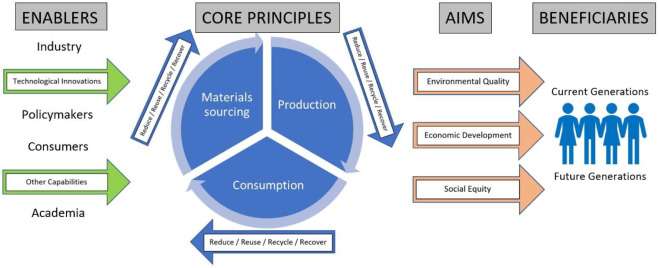The convergence of the circular economy and sustainable development represents a paradigm shift in how we approach resource management and economic growth. It’s a powerful alliance that challenges the traditional linear model of “take-make-dispose” which has proven unsustainable in the face of dwindling resources and escalating environmental pressures. This new approach offers a vision where waste is minimized, resources are valued, and economic prosperity is intrinsically linked to environmental well-being. Embracing the principles of the circular economy is not merely a trend but a necessity for securing a future where both humanity and the planet can thrive.
Understanding the Circular Economy
The circular economy is a regenerative system in which resource input and waste, emission, and energy leakage are minimized by slowing, closing, and narrowing material and energy loops. This can be achieved through:
- Design for durability and recyclability: Creating products that last longer and are easily disassembled for component reuse or recycling.
- Material selection: Prioritizing renewable, non-toxic, and recyclable materials.
- Product as a service (PaaS): Shifting from ownership to access, encouraging manufacturers to design for longevity and performance.
- Closed-loop systems: Implementing systems that recover and reuse materials, minimizing waste.
Benefits of the Circular Economy
Adopting circular economy principles offers a multitude of advantages, including:
- Reduced resource depletion: Minimizing the extraction of virgin resources, conserving precious natural capital;
- Waste reduction: Diverting waste from landfills and incineration, mitigating environmental pollution.
- Economic opportunities: Creating new jobs and industries in areas such as recycling, remanufacturing, and product refurbishment.
- Enhanced resilience: Reducing reliance on volatile global supply chains, fostering greater economic stability.
Sustainable Development: A Broader Perspective
Sustainable development, as defined by the Brundtland Commission, is “development that meets the needs of the present without compromising the ability of future generations to meet their own needs.” It encompasses three pillars: economic development, social equity, and environmental protection. It’s about creating a world where everyone has the opportunity to thrive, without depleting the resources needed for future generations.
The concept of sustainability is deeply intertwined with the health of our planet. Failing to respect the Earth’s boundaries and exceeding planetary limits will lead to cascading consequences, including resource scarcity, climate change, and loss of biodiversity.
The Synergistic Relationship
The circular economy acts as a powerful tool for achieving sustainable development goals. By minimizing waste, maximizing resource efficiency, and promoting sustainable consumption and production patterns, the circular economy directly contributes to environmental sustainability.
Furthermore, the circular economy fosters innovation and creates new economic opportunities, contributing to economic development. When coupled with strong social policies that ensure equitable access to resources and opportunities, the circular economy can also promote social equity.
Moving Forward: Embracing the Circular Economy for Sustainable Development
The transition to a circular economy requires a collective effort from governments, businesses, and individuals. Governments must create supportive policy frameworks, businesses must innovate and adopt circular business models, and individuals must embrace sustainable consumption habits. Together, we can create a future where economic prosperity and environmental stewardship go hand in hand. Only by working together can we hope to achieve a truly sustainable future for all.
Challenges and Opportunities
While the potential of the circular economy is undeniable, several challenges impede its widespread adoption. One major hurdle is the lack of standardized metrics and reporting frameworks. Without clear and consistent ways to measure circularity, it becomes difficult for businesses to track their progress and for consumers to make informed choices. Furthermore, the initial investment required to transition to circular business models can be a deterrent for some companies, particularly small and medium-sized enterprises (SMEs).
However, these challenges also present significant opportunities. The development of robust circularity metrics can drive innovation and create a level playing field for businesses. Governments can play a crucial role by providing financial incentives and technical assistance to support SMEs in their transition to circular models. Moreover, increasing consumer awareness and demand for sustainable products can create a strong market pull for circular solutions.
Policy Levers for a Circular Transition
Governments have a vital role to play in accelerating the transition to a circular economy. Key policy levers include:
- Extended Producer Responsibility (EPR) schemes: Holding producers responsible for the end-of-life management of their products, incentivizing them to design for recyclability and durability.
- Green public procurement: Prioritizing the purchase of sustainable and circular products and services by government agencies.
- Tax incentives and subsidies: Providing financial support for businesses that invest in circular technologies and practices.
- Regulations and standards: Setting minimum requirements for product recyclability and durability, and phasing out harmful substances.
- Awareness campaigns: Educating consumers about the benefits of circularity and encouraging sustainable consumption habits.
Case Studies: Circularity in Action
Across various sectors, businesses are already demonstrating the viability and benefits of circular business models. In the fashion industry, companies are exploring rental services, resale platforms, and textile recycling initiatives to reduce waste and extend the lifespan of clothing. In the electronics industry, manufacturers are designing products for easier disassembly and component reuse, and offering take-back programs for end-of-life devices. In the construction industry, companies are utilizing recycled materials and designing buildings for deconstruction and material recovery.
These case studies showcase the diverse applications of circular economy principles and highlight the potential for innovation across all sectors of the economy. By sharing best practices and scaling up successful models, we can accelerate the transition to a more circular and sustainable future.
Ultimately, the success of the circular economy hinges on a fundamental shift in mindset. We must move away from the linear “take-make-dispose” model and embrace a more holistic and regenerative approach to resource management. This requires a commitment to innovation, collaboration, and a shared vision of a sustainable future. The journey towards a circular economy is not without its challenges, but the potential rewards – a healthier planet, a more resilient economy, and a more equitable society – are well worth the effort.

